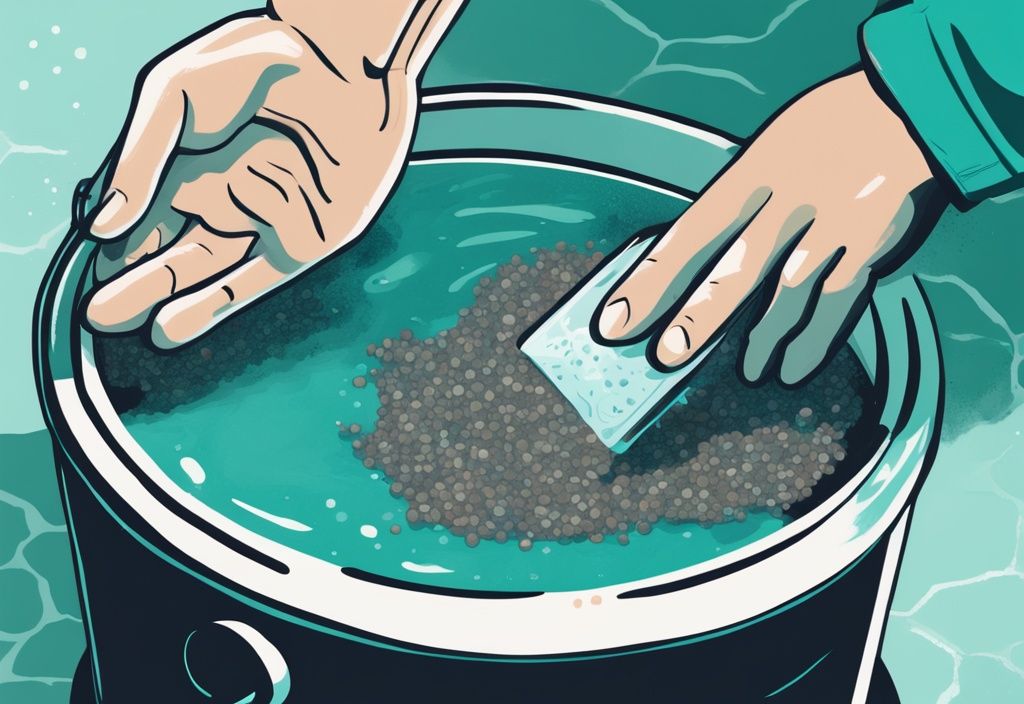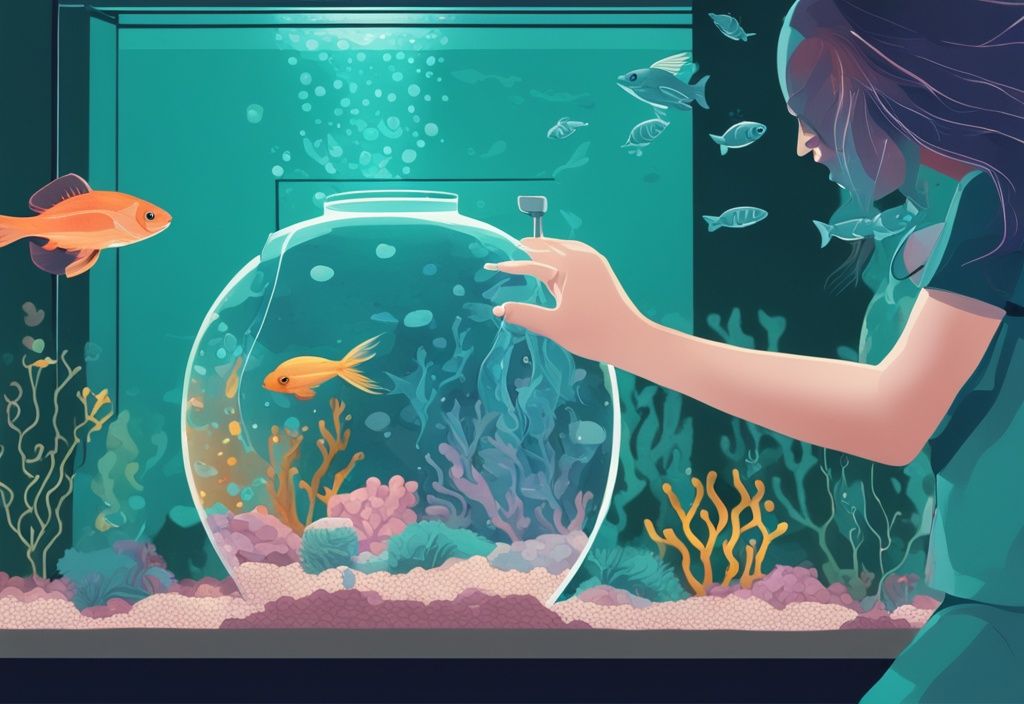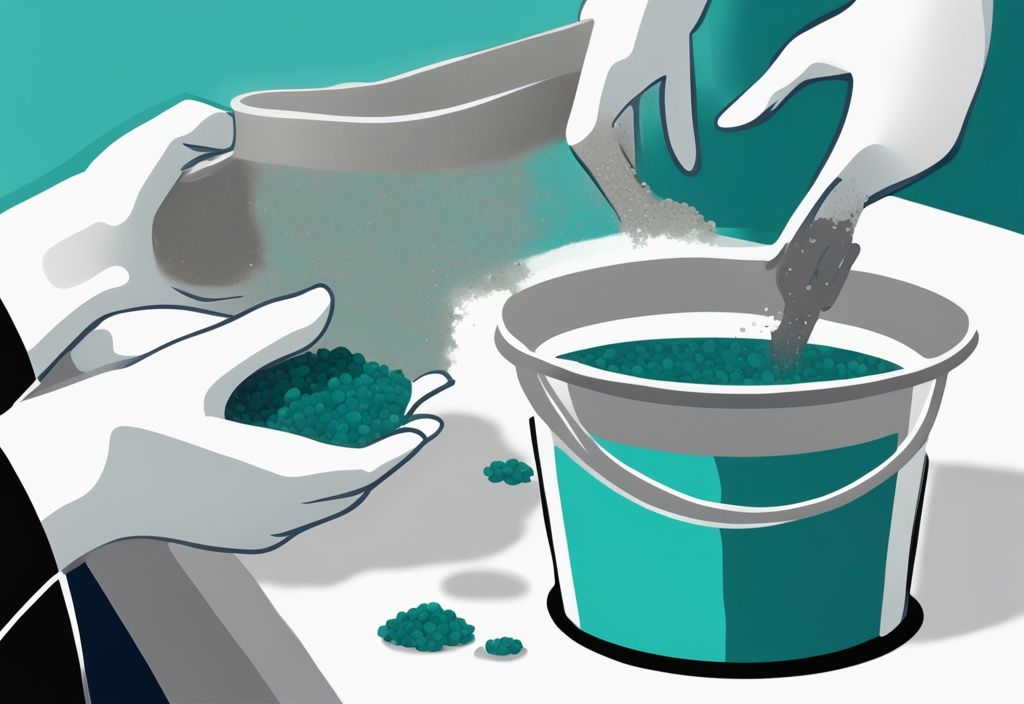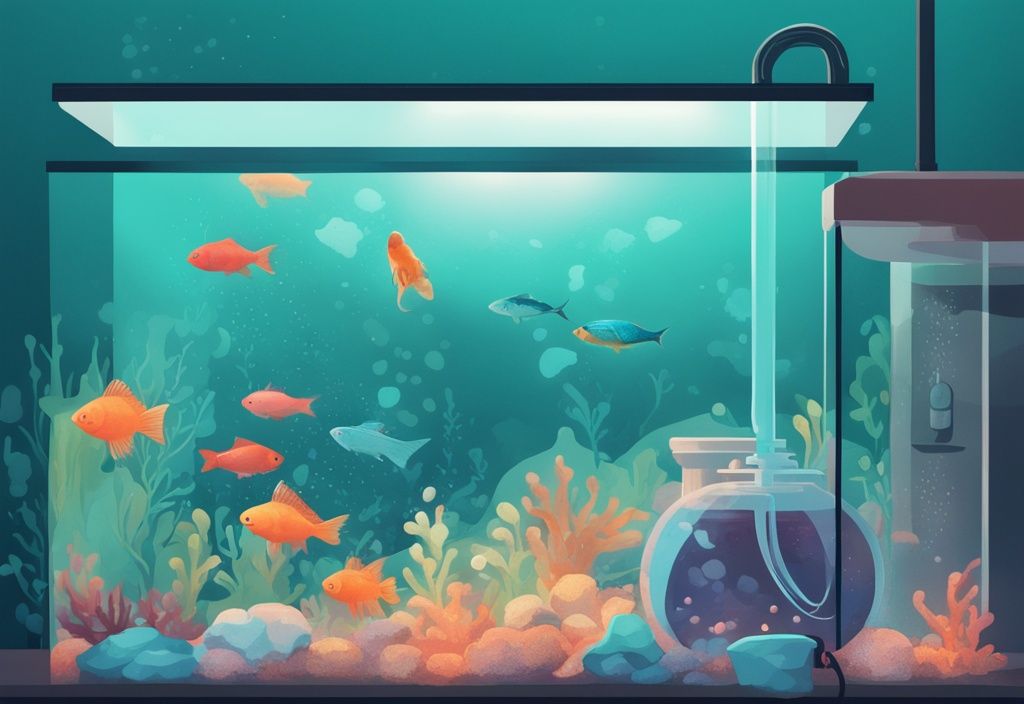Did you know that keeping your aquarium gravel clean is like providing a breath of fresh air to your aquatic pets? Hi, I’m Dr. Melanie Rivers, and learning how to clean aquarium gravel was one of the first lessons in my two-decade-long journey as a marine biologist.
Our focus here is simple but vital – aquarium gravel. Often overlooked, these tiny pebbles can become a breeding ground for toxins and waste, compromising your tank’s health. This crystal-clear guide will illuminate the path to pristine tanks, revealing essential tools and safety measures for your clean-up mission. For more information on fish care, check out this helpful resource: https://www.petmd.com/fish/care/evr_fi_how-to-care-of-fish.
Join me as we dive deeper into cultivating a balanced underwater world. After all, a clean home is a happy home, even for our fishy friends. Let’s foster thriving aquatic ecosystems together, one gravel at a time.
Why Aquarium Gravel Cleaning Matters
Aquarium gravel cleaning is crucial for sustaining a healthy ecosystem within your fish tank. It effectively removes waste and detritus that accumulate over time, thereby improving water quality. Understanding how to clean aquarium gravel properly is essential to maintaining this delicate balance.
Impact on Fish Health
Consistent gravel cleaning prevents harmful toxins from building up. These toxins can lead to serious illnesses or even death among your fish. A clean environment minimizes stress, boosts overall well-being, and reduces disease and parasite risks by removing decaying organic matter.
Controlling Algae Growth
Regular gravel cleaning is a key tactic to control algae growth. Algae feast on waste products, and by eliminating these excess nutrients, you effectively curb the algae’s growth rate. This ensures a clearer and more aesthetically pleasing aquarium.
Promoting Nitrogen Cycle
Proper gravel cleaning aids in maintaining the nitrogen cycle. Clean gravel retains beneficial bacteria that are instrumental in nitrification—a process crucial for balancing ammonia, nitrites, and nitrates in the aquarium. This balance is vital for the sustainability of your aquatic ecosystem.
Understanding how to clean aquarium gravel correctly can significantly enhance your fish tank’s health, providing a less stressful and more disease-resistant environment for your fish while also managing algae and promoting vital bacterial activity.
Essential Tools for Gravel Cleaning
Gravel Vacuum or Siphon
Gravel vacuums or siphons are indispensable when learning how to clean aquarium gravel effectively. These tools streamline the removal of debris from the gravel bed, making the cleaning process both efficient and less intrusive for your fish.
The choice between a manual and an electric vacuum influences the ease of use and overall effectiveness. Manual vacuums require a pumping motion to start the water flow, making them more labor-intensive but cost-effective. Electric vacuums, on the other hand, offer automated suction, simplifying the process but at a higher price point.
Buckets or Hose System
An essential component of the gravel cleaning process involves transporting and disposing of dirty water. Using buckets or a hose system ensures a clean and spill-free method to manage wastewater.
Buckets are practical for small to medium tanks, providing control over water removal and helping maintain a tidy environment. Hose systems are ideal for larger aquariums, allowing direct drainage into sinks or outdoor areas, thus reducing manual labor. Both methods are vital for maintaining a clean aquarium setup while preventing water spills.
Sieve or Colander
When manually cleaning your aquarium gravel, a sieve or colander becomes extremely useful. This tool aids in effectively rinsing the gravel, ensuring thorough cleaning while preventing any loss of gravel.
During the rinsing process, a colander captures debris, waste, and food particles, allowing only clean gravel to return to the tank. This granular control is vital for maintaining the integrity of your aquarium substrate. Using a sieve or colander helps ensure that your gravel is free from contaminants, contributing to a healthier and more balanced aquatic environment.
Preparing for Gravel Cleaning
Safety Measures When Cleaning
When it comes to learning how to clean aquarium gravel, ensuring the safety of both you and your aquatic pets is paramount. Several crucial precautions can significantly reduce risks and ensure a smooth cleaning process:
- Avoid Using Harsh Chemicals: Ensure you steer clear of any cleaning agents or chemicals. These substances are harmful to fish and can disrupt the delicate chemical balance in your tank. Imagine your fish swimming in a chemical soup—not ideal, right? To ensure a healthy environment, it’s also important to know how to clean aquarium decorations.
- Wear Protective Gear: Always wear gloves when cleaning your aquarium gravel. Gloves act as a barrier, protecting your skin from potential contaminants and bacteria present in the tank water and substrate. Think of it like putting on a pair of gloves before gardening. It’s a small step that makes a huge difference.
- Turn Off Electrical Equipment: Before you start cleaning, make sure to turn off and unplug all electrical equipment connected to the aquarium. This precaution prevents any potential electrical shocks, which can occur if water comes into contact with electrical devices. Water and electricity are a dangerous duo, so let’s keep them apart!
Adhering to these safety measures will ensure that your experience in maintaining your aquarium remains both safe and effective. By protecting yourself and your aquatic ecosystem, you increase the longevity and health of your fish environment.

Step-By-Step Guide to Aquarium Gravel Cleaning
Cleaning aquarium gravel is crucial for maintaining a healthy, vibrant environment for your aquatic friends. This guide will cover effective methods using a gravel vacuum and manual cleaning techniques.
Using a Gravel Vacuum
Operating The Vacuum
Submerge the wide end of the vacuum into the water, keeping the other end above the surface.
Depending on your vacuum type, initiate the water flow with a pumping motion or a self-starting mechanism. As water starts flowing, gently move the vacuum head through the gravel. This action will dislodge detritus and debris, which will then be sucked into the vacuum, leaving your gravel clean.
Ensuring Effective Gravel Cleaning
Focus on particularly dirty spots to maximize efficiency. Control the rate of water flow by pinching the hose. This helps to avoid removing excessive water or gravel from the tank. If you’re wondering what fish are suitable for a 3-gallon tank, you can find more information here: what fish for 3 gallon tank. Continue vacuuming until the water being siphoned is clear, or you have replaced about 25-30% of the tank’s water. This approach ensures a clean environment without disturbing the balance too much.
Manual Cleaning of Aquarium Gravel
Pros & Cons of Tap Water Rinsing
Rinsing aquarium gravel with tap water is an easy and quick method. Tap water is readily available, making it a convenient option. However, tap water often contains chlorine, which can be harmful to the beneficial bacteria in your aquarium. To mitigate this, always dechlorinate the tap water before using it for cleaning. Use a suitable conditioner to neutralize the chlorine and protect the aquatic ecosystem.
Is Boiling Necessary?
Boiling gravel is generally not necessary for routine cleaning. Nonetheless, boiling can be an effective method for thorough sanitization, ensuring complete sterilization of the gravel. This process eradicates bacteria and other microorganisms. However, boiling is typically considered overkill for regular maintenance and should only be employed if the situation requires stringent cleanliness. For regular upkeep, simple rinsing with dechlorinated water is usually sufficient.
Post-Cleaning Care for Your Aquarium
When cleaning your aquarium gravel, it’s crucial to follow specific post-cleaning steps to ensure a balanced and healthy environment for your aquatic life. This section will guide you through re-installing the cleaned gravel and reintroducing your fish to their refreshed home.
Re-installing Cleaned Gravel
Once you’ve diligently cleaned the aquarium gravel, the next step is to reintroduce it with care. Begin by spreading the clean gravel evenly across the tank bottom. This not only enhances the tank’s natural beauty but also prevents the accumulation of debris in uneven areas.
Make sure that all decorations and plants are securely anchored in the gravel. Proper anchoring is vital to prevent them from floating or shifting, maintaining the aesthetic and functional balance of the tank.
Before you reintroduce your fish, double-check for any lingering debris or waste that might have been missed. Even small particles can compromise water quality, negating your hard work. By ensuring a thorough clean, you set up a pristine and stable environment for the next phases of maintenance.
Introducing Fish Back into The Aquarium
Returning your fish to the aquarium is a delicate and methodical process essential for reducing stress and ensuring a smooth transition. First, confirm that all water parameters—such as temperature, pH, and hardness—are stabilized and suitable for your fish species. Stable conditions are crucial as fish are highly sensitive to environmental changes.
Once the water parameters are optimal, carefully place the fish back into the tank. Observing their behavior closely in the ensuing hours is crucial. Fish stress from environmental changes can manifest quickly, impacting their health.
Pay attention to their behavior; early intervention in case of any issues can ensure a safe and smooth transition back into their clean and healthy habitat. This attentive approach contributes significantly to maintaining a balanced and thriving aquarium ecosystem.
By following these detailed steps, you not only enhance your aquarium’s beauty but also foster a sustainable and harmonious underwater world for your fish and plants.
Important Tips to Maintain Clean Gravel
Feeding Practices to Reduce Gravel Dirt
Understanding how to clean aquarium gravel effectively begins with adjusting your feeding practices. Overfeeding is a common challenge, leading to excess food settling in the gravel, which compromises water quality and creates an unclean environment.
To prevent this, adhere to a regulated feeding schedule tailored to your fish species, generally once or twice a day in small, manageable quantities. By observing the amount of food your fish consume within a few minutes, you’ll minimize waste build-up and maintain a cleaner substrate.
Implementing these practices not only keeps the gravel clean but also promotes the overall health of your aquatic pets. Just think of it like keeping your kitchen tidy by avoiding food scraps on the floor—only underwater!

Role of Regular Water Changes
Regular water changes are indispensable for those aiming to master how to clean aquarium gravel. Performing partial water changes of 10-15% weekly or bi-weekly helps in reducing the accumulation of waste products like uneaten food, fish waste, and toxins.
These contaminants, if left unchecked, can get trapped in the gravel, promoting unwanted algae growth and creating hazardous conditions for your fish. By frequently replacing part of the tank water, you will continuously remove these impurities, thereby improving the overall water quality.
Consistent water changes also help in maintaining stable water chemistry, which is vital for the health and longevity of your aquarium’s inhabitants. Remember, it’s like routinely changing the oil in your car to ensure it runs smoothly and efficiently. Likewise, keeping your tank water fresh will pay dividends in a healthy, balanced aquatic ecosystem.
Signs Your Aquarium Gravel Needs Cleaning
Maintaining clean aquarium gravel is paramount for a healthy aquatic environment. Spotting the signs that indicate it’s time for cleaning ensures your fish thrive in pristine conditions.
Discoloration of Aquarium Water: If the water in your tank becomes cloudy or tinted, it’s likely due to debris and organic matter accumulating in the gravel, releasing unwanted particles into the water.
Noticeable Foul Smell: A strong, unpleasant odor from your tank signals decomposing organic material within the gravel. Fish waste and uneaten food trapped in the gravel produce harmful gases and deteriorate water quality.
Visible Waste, Food Leftovers, or Fish Remains on the Gravel: Spotting waste, fish food leftovers, or deceased fish parts on your gravel means it’s time for a thorough cleaning. These materials lead to toxic build-ups like ammonia and nitrites, harming your fish.
Frequent Instances of Fish Illnesses: Fish showing signs of stress or frequent illnesses might suffer from dirty gravel-induced poor water conditions. Clean gravel helps prevent disease outbreaks, promoting healthier fish.
When to Clean Gravel in Your Aquarium
Regular maintenance of aquarium gravel ensures a balanced ecosystem for your fish. The ideal cleaning schedule varies based on specific conditions in your tank.
Generally, conduct gravel cleaning once a month: A monthly routine works well for most aquariums, removing waste buildup while preserving beneficial bacteria vital for the nitrogen cycle.
Frequency may vary based on the number of fish, filtration system, and maintenance routine: Adjust the cleaning schedule based on your tank’s specifics. Heavily stocked tanks or frequent feeding may demand more frequent cleaning, while efficient filtration systems and lower fish loads can afford longer intervals between cleanings.
Maintaining clean aquarium gravel ensures a pristine environment, promoting the well-being of your fish and the overall health of your tank’s ecosystem. Regularly monitoring and addressing these signs will help you maintain optimal conditions for your aquatic inhabitants.
Cleaning Different Aquarium Substrate Types
Caring for various aquarium substrates requires distinct cleaning techniques to maintain a healthy aquatic environment. This section will guide you through different cleaning methods to ensure your tank remains in optimal condition.
Substrates to Avoid Vacuuming
Certain aquarium substrates, such as sand or planted tank substrates, are best left unvacuumed. These materials necessitate special care to preserve the delicate ecological balance within your tank. Vacuuming can sometimes be more harmful than beneficial, especially when dealing with fine sand or areas with fragile plant roots.
The fine particles of sand can be easily sucked up by the vacuum, reducing the substrate level and causing cloudiness in your aquarium water. Moreover, disturbing planted tank substrates can unsettle plant roots and release nutrients into the water column, potentially leading to unwanted algae growth.
Cleaning Techniques for Various Substrates
When it comes to sand beds, it’s crucial to handle them gently during the cleaning process. Instead of plunging into the sand with a gravel vacuum, hover the siphon head just above the surface. This method allows you to pick up detritus and waste without removing the valuable sand.

Keeping the siphon above the sand helps maintain its level and prevents unnecessary disruption. For tanks with sand substrates, it’s also essential to manually disturb the sand bed on occasion. This practice helps prevent the formation of toxic hydrogen sulfide pockets, which can build up in undisturbed areas and be harmful to fish when released.
Gently stirring the sand aids in the aeration of the substrate, maintaining a healthier environment for your aquatic life. With other specialized substrates, such as those in planted tanks, careful research and application of substrate-specific cleaning methods are paramount.
Each type of substrate brings its own set of demands and requires tailored approaches to retain its balance and functionality. This often involves minimal disturbance and specific techniques to support both the biological and mechanical filtration systems.
Always consult dedicated resources or experts to ensure your cleaning regimen is appropriate for your aquarium’s particular substrate type.
Final Thoughts on Cleaning Aquarium Gravel
Regular gravel cleaning is one of the most crucial steps in maintaining a healthy and vibrant aquarium environment. It plays a pivotal role in ensuring the well-being of your aquatic life and the overall aesthetic appeal of your tank. When learning how to clean aquarium gravel properly, remember that technique and consistency are key. Additionally, mastering how to clean aquarium sand can further enhance your tank’s maintenance routine. Proper gravel cleaning reduces the accumulation of harmful debris, waste, and detritus that can compromise water quality. This not only enhances the appearance of your aquarium but also creates a safer, more comfortable habitat for your fish.
Using the appropriate tools, such as a gravel vacuum or siphon, simplifies the cleaning process. These tools help in efficiently removing detritus without disturbing the beneficial bacteria that live in the substrate. Remember, beneficial bacteria are essential for maintaining the nitrogen cycle, which keeps ammonia, nitrites, and nitrates in balance.
Prioritizing safety measures is another critical aspect. Avoid using any chemicals or cleaning agents that could harm your fish. Wearing gloves and ensuring all electrical equipment is turned off during cleaning are essential precautions to prevent accidents.
Beyond proper cleaning techniques, frequency and observation are significant. Regular gravel cleaning, typically once a month, helps in keeping your tank in optimal condition. However, always stay vigilant for signs that indicate the need for cleaning, such as discolored water, foul smells, visible waste, or frequent fish illness.
Lastly, understanding that different substrates may require unique cleaning methods is important. For example, sand substrates or planted tank substrates need careful handling to avoid disrupting the tank’s balance.
By maintaining a routine, using the right tools, and following safe procedures, you ensure a thriving and beautiful aquarium environment, promoting the health and longevity of your aquatic pets.
FAQ
Ideal Gravel Cleaning Frequency
When considering how to clean aquarium gravel effectively, frequency is key. Ideally, gravel cleaning should be carried out once a month. However, this can vary based on specific tank conditions, such as the number of fish and the efficiency of your filtration system. Monitoring your tank’s health and appearance will help you determine the best cleaning schedule.
Can I Use Tap Water for Gravel Cleaning?
Many aquarists wonder whether they can use tap water for cleaning aquarium gravel. The answer is yes, but with an important caveat: dechlorinate the water first. Tap water contains chlorine, which can harm the beneficial bacteria in your aquarium and stress your fish. Always use a water conditioner to neutralize chlorine before using tap water for cleaning gravel.
Addressing Foul Smelling Gravel
If your aquarium gravel emits a foul odor, it’s time for a thorough cleaning. Stick to a regular cleaning schedule to prevent unpleasant smells. Overfeeding is a common culprit behind smelly gravel, as uneaten food decomposes and produces odors. Also, a well-functioning filtration system is crucial. It helps maintain cleanliness by removing waste and decaying matter from the water.
Importance of Removing Fish During Cleaning
Removing fish during gravel cleaning is crucial for their well-being. The process can stir up debris and toxins that might stress or harm your fish. By temporarily transferring them to a safe environment, you reduce their exposure to these hazards. This simple step can significantly minimize stress-induced health issues, ensuring your fish remain healthy and happy.
The Debate Around Boiling Gravel for Cleaning
The concept of boiling gravel for cleaning often comes up in discussions among aquarists. Generally, boiling is unnecessary and can be seen as overkill. While it’s effective at killing bacteria, routine cleaning typically suffices to maintain a healthy aquarium environment. Reserve boiling for situations where complete sterilization is necessary, and ensure your regular cleaning practices keep your tank in excellent condition.
